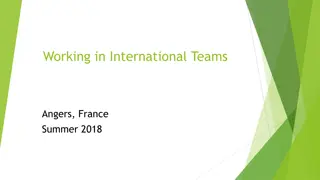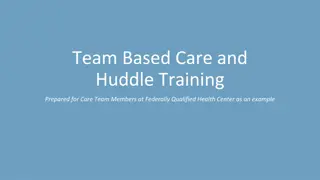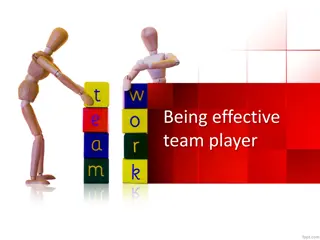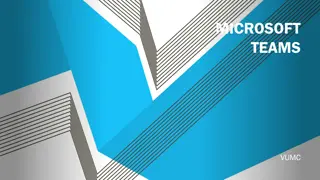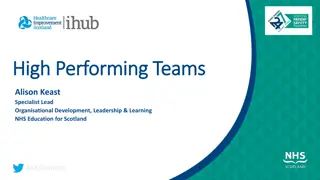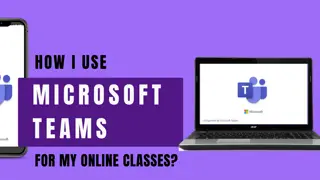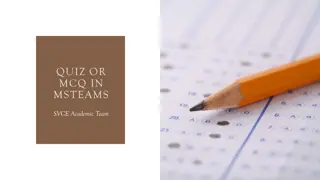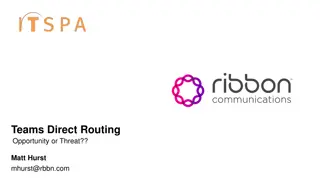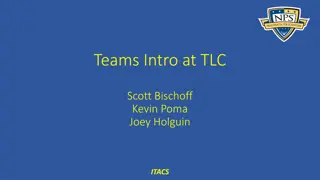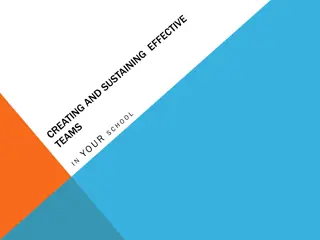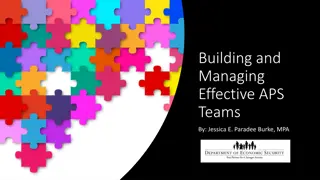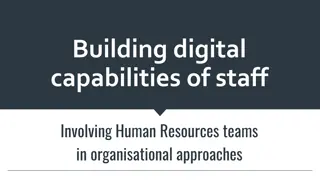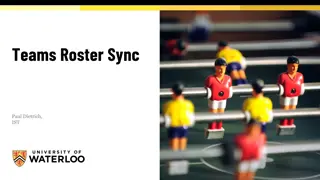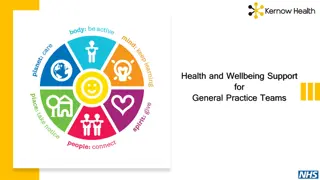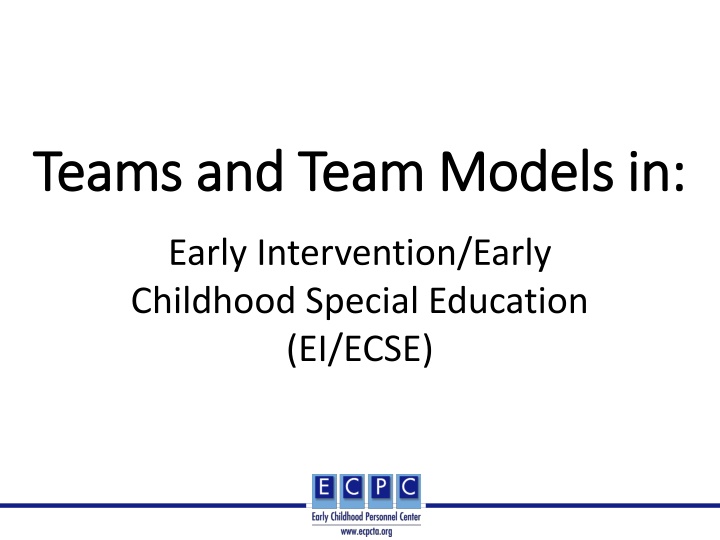
Effective Team Models in Early Childhood Special Education
Explore team models in Early Intervention/Early Childhood Special Education (EI/ECSE) including characteristics of effective teams, multidisciplinary, interdisciplinary, and transdisciplinary approaches. Learn how practitioners collaborate with families and professionals from various disciplines to support children's unique needs.
Download Presentation

Please find below an Image/Link to download the presentation.
The content on the website is provided AS IS for your information and personal use only. It may not be sold, licensed, or shared on other websites without obtaining consent from the author. If you encounter any issues during the download, it is possible that the publisher has removed the file from their server.
You are allowed to download the files provided on this website for personal or commercial use, subject to the condition that they are used lawfully. All files are the property of their respective owners.
The content on the website is provided AS IS for your information and personal use only. It may not be sold, licensed, or shared on other websites without obtaining consent from the author.
E N D
Presentation Transcript
Teams and Team Models in: Teams and Team Models in: Early Intervention/Early Childhood Special Education (EI/ECSE)
EI/ECSE Standard 3, EI/ECSE Standard 3, Component 3.1 Component 3.1 Candidates apply teaming models, skills, and processes, including appropriate uses of technology, when collaborating and communicating with families; professionals representing multiple disciplines, skills, expertise, and roles; and community partners and agencies.
DEC Recommended DEC Recommended Practices (RPs, 2014) Practices (RPs, 2014) TC1 Practitioners representing multiple disciplines and families work together as a team to plan and implement supports and services to meet the unique needs of each child and family. TC2 Practitioners and families work together as a team to systematically and regularly exchange expertise, knowledge, and information to build team capacity and jointly solve problems, plan, and implement interventions.
DEC Recommended DEC Recommended Practices (RPs, 2014) Practices (RPs, 2014) TC3 Practitioners use communication and group facilitation strategies to enhance team functioning and interpersonal relationships with and among team members.
Objectives Objectives Define and describe The characteristics of effective teams. Describe and compare Multidisciplinary, interdisciplinary, and transdisciplinary team models.
Teams and Their Teams and Their Characteristics Characteristics
Alone we can do so little; together we can do so much. - Helen Keller
Team Team Individuals from multiple disciplines and the family who work together to achieve the child and family s outcomes/goals.
Characteristics of Teams Characteristics of Teams Common goal(s). Interdependence of members. Belief that working together leads to more effective decisions than working alone. Accountability as a unit within a larger organizational context.
Effective Teams Adhere to Effective Teams Adhere to These Principles: These Principles: Articulate goal(s). Articulate role expectations of team members. Utilize effective communication strategies. Employ a structured approach to problem-solving and decision-making. Identify strategies for resolving conflict.
Functions of Teams in EI/ECSE Functions of Teams in EI/ECSE Assessment, Individualized program planning IFSP/IEP development, Individualized planning for intervention and instruction, Implementation of intervention and instruction, Inter- and intra-agency coordination, and Professional development.
Tuckmans Five Stages of Team Tuckman s Five Stages of Team Development Development Tuckman s Five Stages of Team Development (1:27) 1. What are Tuckman s five stages? 2. What are the main characteristics of each stage? 3. For a team in which you are currently a member, identify the team s stage of development.
Team Members in EI/ECSE Team Members in EI/ECSE
The Family The Family The family is an equal partner in decision-making on both Part C and Part B/619 teams.
Service Providers IDEA Part C Service Providers IDEA Part C (303.13) (303.13) Audiologists Physical therapists Family therapists Psychologists Registered dieticians Social workers Special educators Nurses Occupational therapists Orientation and mobility specialists Speech language pathologists Pediatricians, other physicians Vision specialists
IDEA Part B/619 Educators IDEA Part B/619 Educators
Related Service Providers Related Service Providers IDEA Part B/619 (Sec. 300.34) IDEA Part B/619 (Sec. 300.34) Physical therapists Recreation specialists School nurses Speech language pathologists Interpreters Audiologists Social workers Psychologists Licensed physicians Occupational therapists Orientation and mobility specialists
Team Models in EI/ECSE Team Models in EI/ECSE
Team Models in EI/ECSE Team Models in EI/ECSE Multidisciplinary Interdisciplinary Transdisciplinary
Multidisciplinary Team Model Multidisciplinary Team Model Discipline specific, well-defined roles, Team functions planned and implemented independently, and Communication primarily in required meetings (e.g., IFSP, IEP).
Interdisciplinary Team Model Interdisciplinary Team Model Discipline specific roles. Services provided by discipline specific team member. Team members meet and/or communicate regularly.
Transdisciplinary Team Model Transdisciplinary Team Model Roles shared across disciplines and with the family. Shared objectives/outcomes based on IFSP or IEP. Ongoing communication among team members. Characterized by the role release process.
The Role Release Process The Role Release Process (King et al., 2009) (King et al., 2009) (King et al., 2009)
Role Release Process Role Release Process Role extension increasing depth of knowledge/skill in each team members own discipline Role enrichment teaching/learning concepts, information, language across disciplines Role expansion increasing knowledge and skills across disciplines Role exchange apply new skills while supervised by team member from that discipline Role release integrate practices and interventions from other disciplines Role support periodic observation and consultation by discipline specific team members
Role Release Role Release Activity Activity Janella s Story (11:33) What aspects of the role release process are exemplified in the video? How are other team members involved? What does the mother identify as benefits of the transdisciplinary model? The EI?
Advantages/Disadvantages of the Advantages/Disadvantages of the Transdisciplinary Team Model Transdisciplinary Team Model Advantages Disadvantages Family equal team member, Leadership support critical, Regular meetings, Time for meetings, Team members gain information and practices, Commitment of all team members to model, One primary provider, and Team members willing to share expertise with other team members, and Other professional team members in consultant role. Funding policies.
When Role Release May When Role Release May Not Be Appropriate? Not Be Appropriate? Child with specific diagnosis that requires expertise of a specific discipline, Child with specific issues (e.g., feeding), and Child who is medically fragile.
How Services Are Provided Based How Services Are Provided Based on the Team Model on the Team Model Multidisciplinary Separate Interdisciplinary Transdisciplinary Assessment Separate Team members and family engage in comprehensive assessment together Family participation Meet w/individual disciplines Meet with team or team rep Full and active members of team Service plan development Separate plans by discipline Share separate plans with one another Team and family develop together based on family priorities, needs Service plan responsibility Responsible for their section Responsible for sharing information as well as implementation of their section Team members implement their section of the plan individually and incorporate other sections where possible Team responsible for how primary service provider implements every section of the plan A primary service provider (can change over time) is assigned to implement plan with family: need for disciplines to share their knowledge with others to ensure full implementation Service plan implementation Implement discipline-specific section of the plan individually Lines of communication Informal lines Periodic case-specific meetings Regular team meetings where continuous transfer of information occurs between all members of the team
Activity: Multidisciplinary, Activity: Multidisciplinary, Interdisciplinary, or Transdisciplinary? Interdisciplinary, or Transdisciplinary? For each of the examples below, determine if the multidisciplinary, interdisciplinary, or transdisciplinary model is being used. _____ Three-year-old is being assessed individually by a PT, OT, SLP, and School Psychologist for possible developmental delay and each writes a summary report. _____ The EI provider makes a home visit to the Garcia family one time per week and implements the motor, communication and cognitive outcomes from the child s IFSP in collaboration with the mom. The EI provider meets with the other team members to discuss the child s ongoing intervention and progress. _____ The PT, SLP, and EI provider each go to the ABC Childcare one time per week and work with a 1 year old with Down syndrome on their IFSP outcomes. They meet monthly to discuss progress, changes in status, and any changes in intervention.
References and Resources References and Resources Code of Federal Regulations (eCFR). (2021). Part 303 Early intervention for infants and toddlers with disabilities. National Archives. https://www.ecfr.gov/current/title-34/subtitle-B/chapter- III/part-303#303.13 Division for Early Childhood (DEC). (2014). DEC recommended practices. DEC. https://www.dec- sped.org/dec-recommended-practices Early Childhood Personnel Center (ECPC). (n.d.). ECPC curriculum modules: Professional Standards, Standard 3: Collaboration and teaming . ECPC. https://ecpcta.org/curriculum- module/standard-3-collaboration-and-teaming/ King, G., Strachan, D., Tucker, M., Duwyn, B., Desserund, S., & Shillington, M. (2009). The application of a transdisciplinary model for early intervention services. Infants and Young Children, 14, 1-13. Tuckman, B., & Jensen, M. (1977). Stages of small group development. Group and Organizational Studies, (2), 419-427. U.S. Department of Education. (n.d.). IDEA: Individuals with Disabilities Education Act, Sec.300.34. U.S. Department of Education. Woodruff, G., & McGonigel, M. J. (1988). Early intervention team approaches: The transdisciplinary model. In J. B. Jordan, J. J. Gallagher, P. L. Hutinger, & M. B. Karnes (Eds.), Early childhood special education: Birth to Three (pp. 163-181). Council for Exceptional Children and Division for Early Childhood.
Disclaimer Disclaimer This is a product of the Early Childhood Personnel Center (ECPC) awarded to the University of Connecticut Center for Excellence in Developmental Disabilities and was made possible by Cooperative Agreement #H325B170008 which is funded by the U.S. Department of Education, Office of Special Education Programs. However, those contents do not necessarily represent the policy of the Department of Education, and you should not assume endorsement by the Federal Government


